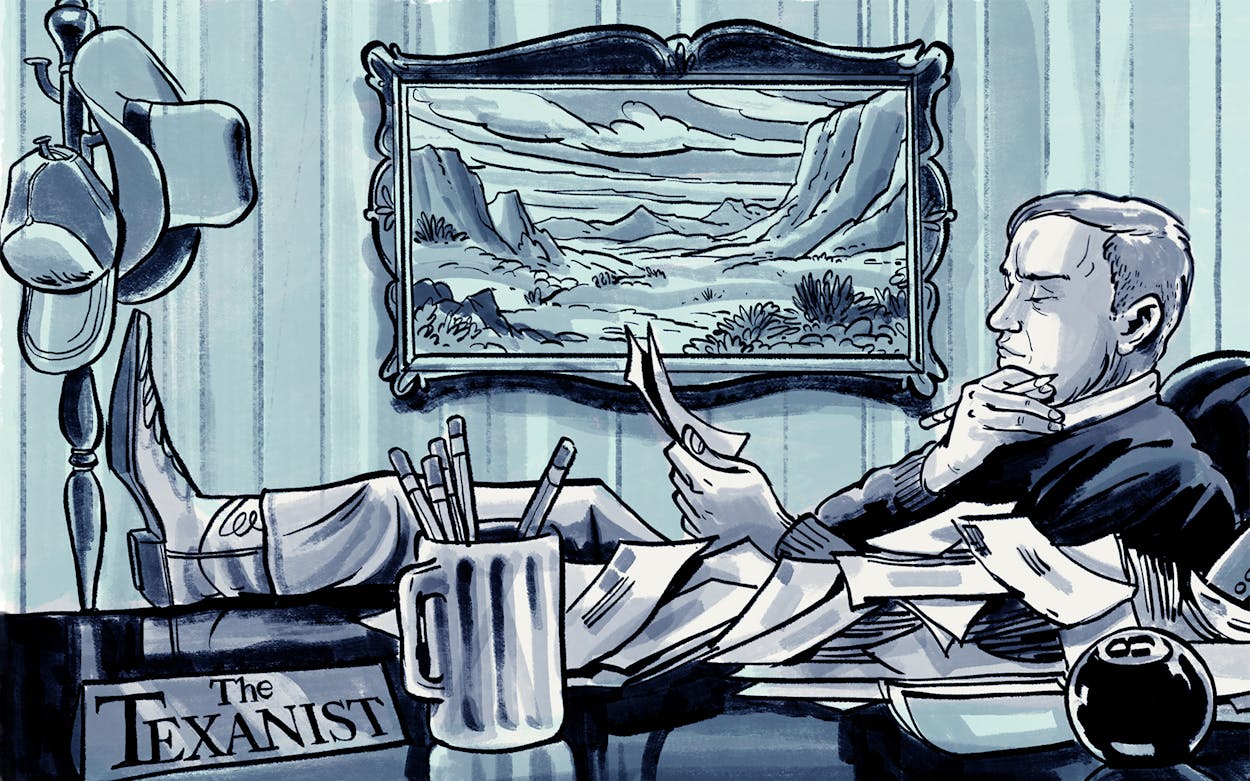Q: It appears to me that Texans have a love affair with all things Texas, including the shape of their state. For example, I have a friend who has an adorable leather purse in the shape of Texas, I have seen waffle irons that create delicious waffles in the shape of Texas, I have cookie cutters in the shape of Texas, and, of course, there are many lovely jewelry items fashioned into the shape of Texas. My list could go on, but you get the idea. Texans love to display the iconic shape of the state of Texas. Do people from other states have this same obsession with the shape of their state?
Molly Little Fann, Boerne
A: And ashtrays, ice cube trays, sunglasses, bottle openers, grills, sinks, wall clocks, wall hangings, Houston rapper Paul Wall’s right hand tattoo, pasta noodles, keychains, tortilla chips, t-shirts, swimming pools, hotel rooftop lazy rivers, coffee cups, coffee tables, etcetera, etcetera, and so forth…. Oh, and lots of tattoos in addition to the one sported by Paul Wall. Yes, the Texanist gets the idea.
Most all Americans, the Texanist would guess, hold some degree of pride in the place they call home. But as all Texans know, the expressions of pride conveyed by those folks pale in comparison to those that emanate from Texans. And what better way to show pride of place than by utilizing the outline of the place itself? The Texanist can think of none.
The outline of Texas is instantly recognizable amid the other forty-nine states, not to mention locales the whole globe over. In fact, the Texanist recently scoured maps and atlases and the depths of his own mind and has determined that Texas is the most distinguishable of all the delineated lands on earth, by a long shot. Second place probably goes to the boot of Italy. Other places are simply square or rectangle or narrow or just blotch-like. Take the identical Dakota twins. Who can even tell them apart? And California? Meh. Long and narrow with a slight crook, California has the shape of a gerrymandered congressional district. Florida? Florida resembles something akin to a link of sausage that’s lost its snap.
These value judgments were borne out in a short but informative piece that Texas Monthly published just a while back. In our March 2017 issue, sociologist James I. Bowie (yes, that is his real name) took a look at data from the United States Patent and Trademark Office and discovered that there are more logos in the shape of Texas than there are in the shape of any other state—more than twice as many as California, and more than three times as many as Florida (sad trombone). It’s not even a contest.
How the shape of Texas came to be is the result of a series of well-known historical events that date back to 1736, when border agreements between the French and the Spanish were first hammered out. And while the current boundaries are pretty much just as they have been since the time of the Compromise of 1850, when lands claimed by the Republic of Texas that reached all the way up to current day Wyoming were forfeited to the federal government by the fledgling State of Texas, conflicts on the matter are not uncommon still. For instance, a heated dispute between the Feds and Texas regarding land along the border with Oklahoma was settled in Texas’s favor just last year.
But though comeliness was presumably not much on the minds of those who determined our final borders, the ever-recognizable outline of Texas, with the Panhandle and the Big Bend and the coastal bend, and all the other unique features, does make for quite the visually pleasing form. This is something upon which all Texans can agree. Of course, we’re undeniably biased in this regard, given the whole burning pride thing. So, in search of an unbiased expert opinion on how the shape of Texas shapes up simply as a shape, the Texanist reached out to the highly reputable Rhode Island School of Design, where he found John Caserta, the head of the graphic design department. Caserta, a native North Carolinian, confessed that his mother once resided in the Texas capital, a place he has visited, but promised not to let this sway his assessment either way.
“With the straight lines and right angles juxtaposed to the curves of the Rio Grande and the Gulf Coast, Texas has enough individual character to be immediately recognizable,” asserted Caserta. “Those straight lines connect it to modernity. The shape isn’t a natural thing, although it was carved out of something natural,” he said. “As opposed to the squares and rectangles of many other states, it has its own shape. In a branding sense, you want something unique enough to be recognizable in its simplest form. Texas has that. It’s distinct. And it works well in Instagram because it fits into a square format.”
The Texanist said he couldn’t have said it better himself, thanked Professor Caserta for his time, and hung up.
The shape of Texas, in addition to being something we celebrate, has become something that celebrates us. It has, over the years, become our brand, a logo that perfectly symbolizes the big, bold, brash, and, well, distinctive Texanness of everyone who resides within the 3,822 miles of straight and squiggly lines that constitute our boundaries. No other state can make such a claim. And this is why you’ve never seen an adorable leather purse in the shape of Illinois, tortilla chips in the shape of Ohio, or waffles in the shape of Hawaii.
Though, come to think of it, the Texanist’s business cards do closely resemble the shape of Colorado. Or is that Wyoming?
Have a question for the Texanist? He’s always available here. Be sure to tell him where you’re from.
A version of this is published in the January 2019 issue.
- More About:
- The Texanist
- Boerne









